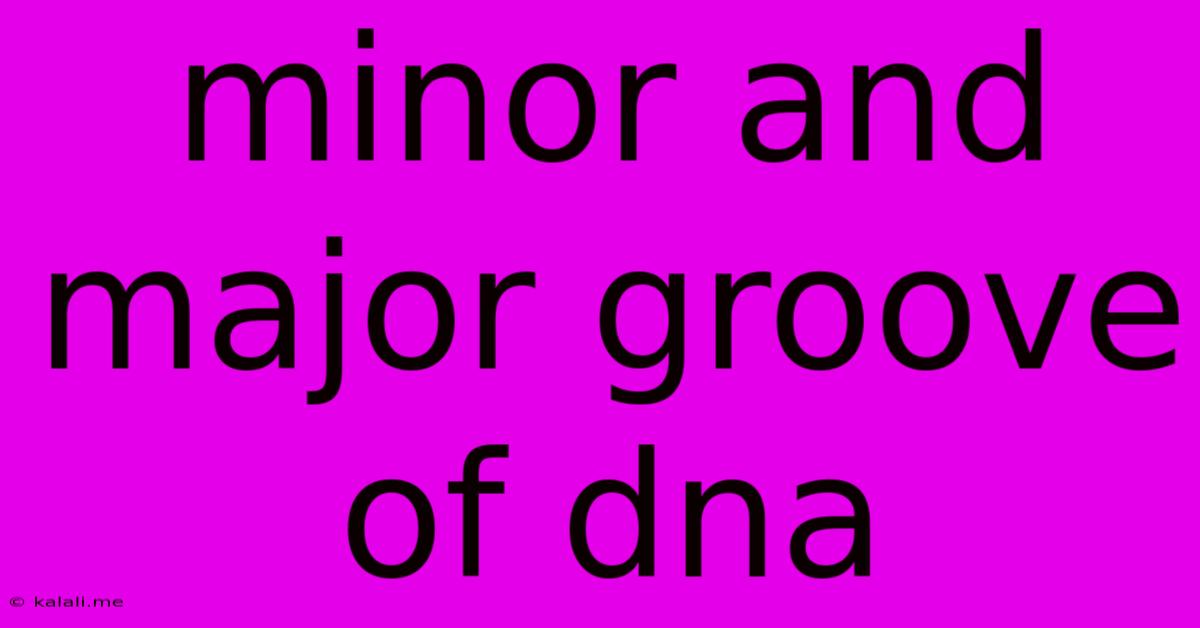Minor And Major Groove Of Dna
Kalali
May 21, 2025 · 3 min read

Table of Contents
Delving into the Depths: Understanding the Minor and Major Grooves of DNA
The DNA double helix, the iconic image of genetics, isn't just a uniform spiral staircase. Its structure contains subtle yet crucial variations in its grooves, creating the major groove and the minor groove. These grooves are not merely aesthetic features; they're functionally significant, playing vital roles in DNA replication, transcription, and the binding of proteins crucial for cellular processes. This article will explore the structure, dimensions, and functional implications of these grooves.
What are the Major and Minor Grooves?
The double helix of DNA is formed by two antiparallel strands of nucleotides, spiraling around a central axis. The twisting nature of the helix creates spaces between the sugar-phosphate backbones of the two strands. These spaces are called grooves, and their differing widths give rise to the major groove and the minor groove. The major groove is wider and deeper than the minor groove. This difference in size directly impacts the accessibility of the DNA base pairs to interacting molecules.
Structural Differences and Dimensions:
The difference in groove width arises from the geometry of the base pairs and the way they are stacked within the helix. The major groove is approximately 22 Å wide, while the minor groove measures around 12 Å. This disparity is a result of the glycosidic bond (the bond linking the base to the sugar) not being directly opposite one another. This asymmetrical arrangement contributes to the unequal spacing and depth of the grooves. Understanding these precise dimensions is crucial for researchers working on DNA-binding proteins and drugs.
Functional Significance: The Key to Protein Binding and Recognition:
The major and minor grooves are not merely structural features; they are crucial for the interaction between DNA and proteins. Many proteins, including those involved in DNA replication, repair, and transcription, recognize and bind to specific DNA sequences. They achieve this binding through interactions with the exposed atoms of the nitrogenous bases within the grooves.
-
Major Groove: The Primary Interaction Site: The major groove exposes more atoms from the bases than the minor groove, making it the primary site for protein recognition. Proteins can "read" the DNA sequence by interacting with specific base pairs within this wider groove, allowing for highly specific binding. This specificity is critical for processes like transcription factor binding, where precise targeting of genes is essential. The presence of specific patterns of atoms within this groove allows for the identification and targeting of particular DNA sequences.
-
Minor Groove: A Supporting Role: While the major groove is the primary interaction site, the minor groove also plays a role in protein binding, particularly for proteins interacting with the DNA backbone. Certain proteins can recognize the shape and structure of the minor groove itself, even without direct interactions with the bases. This binding is often less sequence-specific compared to interactions within the major groove.
Implications in Research and Therapeutics:
The understanding of the major and minor grooves is paramount for several fields of research:
-
Drug Design: Many drugs target specific DNA sequences or DNA-binding proteins. Understanding the geometry and accessibility of the grooves aids in the design of molecules that can bind to specific sites and modulate cellular processes.
-
Gene Editing: Technologies like CRISPR-Cas9 utilize proteins that bind to specific DNA sequences. The specificity of this binding relies heavily on the interaction with the bases exposed in the major groove.
-
Studying DNA-Protein Interactions: Understanding the roles of the grooves is crucial in the study of how different proteins interact with DNA, regulating gene expression and carrying out essential cellular processes.
In conclusion, the major and minor grooves of DNA are far from simple structural features. Their unique dimensions and chemical properties are essential for the intricate processes that govern life. Further research continually unravels the complexities of DNA-protein interactions and the functional significance of these fundamental aspects of DNA's structure.
Latest Posts
Latest Posts
-
How Old Was Samson When He Died
May 21, 2025
-
How Do Tv Series Make Money
May 21, 2025
-
Usb A To Usb A Cable
May 21, 2025
-
Why Does My Alarm Keep Going Off
May 21, 2025
-
To Die Would Be An Awfully Big Adventure
May 21, 2025
Related Post
Thank you for visiting our website which covers about Minor And Major Groove Of Dna . We hope the information provided has been useful to you. Feel free to contact us if you have any questions or need further assistance. See you next time and don't miss to bookmark.